The Impact of Employee Motivation on Job Satisfaction: Woolworths
VerifiedAdded on 2022/08/20
|36
|7786
|13
Report
AI Summary
This report investigates the critical relationship between employee motivation and job satisfaction, focusing on the specific context of Woolworths. The research begins with an introduction outlining the background, aims, objectives, research questions, and hypothesis. A comprehensive literature review explores existing research on employee motivation, encompassing topics such as communication transparency, rewards and recognition, incentive schemes, organizational culture, leadership approaches, HR policies, and training and development. The methodology chapter details the research philosophy, approach, design, and data collection methods, including surveys and interviews. The findings and analysis chapter presents results from both the survey, including descriptive statistics, frequency distribution, reliability, correlation, and regression analyses, and the interviews. The report concludes with a summary of findings, identification of research gaps, suggestions for future research, and practical recommendations for Woolworths to enhance employee motivation and satisfaction. The research aims to identify the contribution of employee motivation in organizational performance, examine different aspects of motivators and employee satisfaction, analyze the correlation between the two within the Woolworths context, and recommend activities to improve employee motivation.
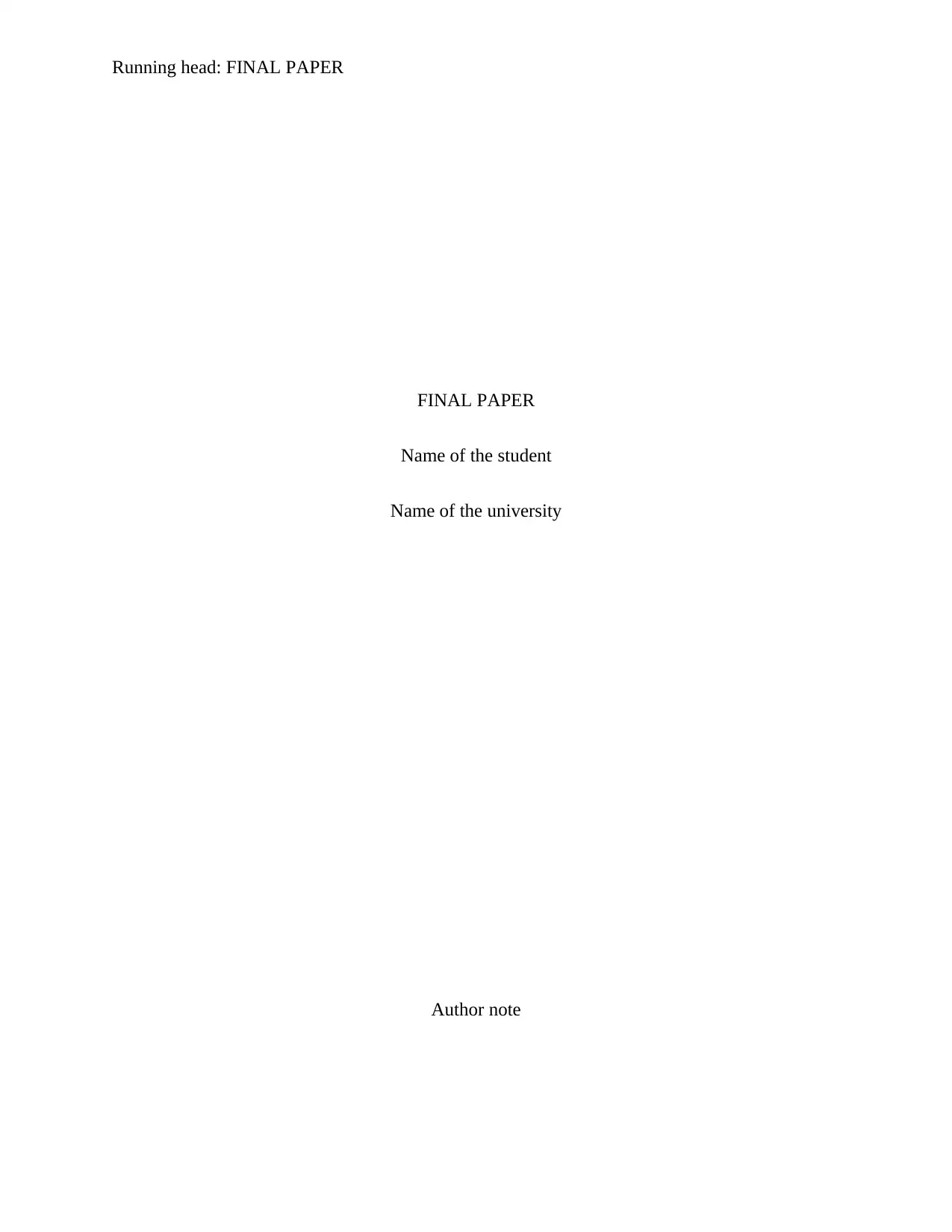
Running head: FINAL PAPER
FINAL PAPER
Name of the student
Name of the university
Author note
FINAL PAPER
Name of the student
Name of the university
Author note
Paraphrase This Document
Need a fresh take? Get an instant paraphrase of this document with our AI Paraphraser
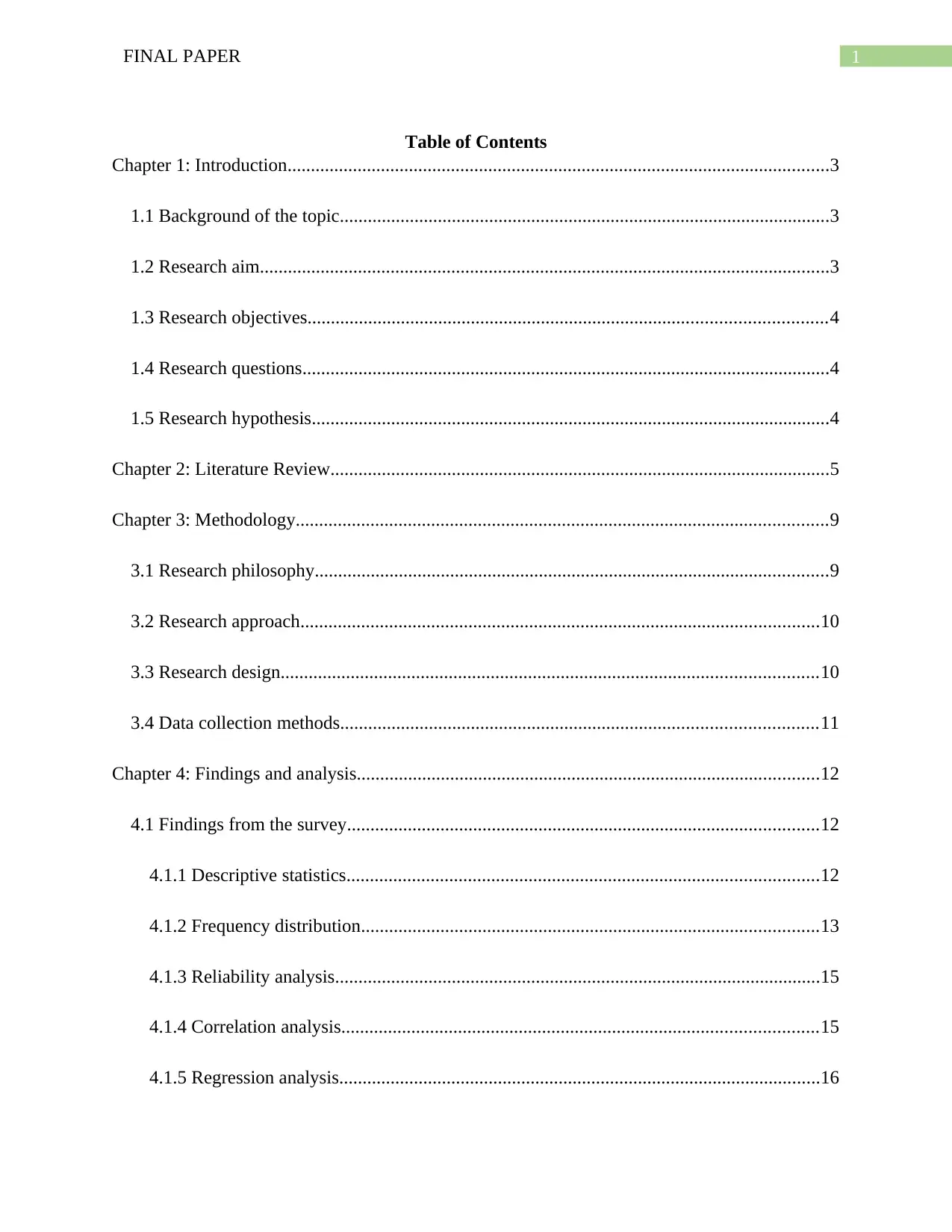
1FINAL PAPER
Table of Contents
Chapter 1: Introduction....................................................................................................................3
1.1 Background of the topic.........................................................................................................3
1.2 Research aim..........................................................................................................................3
1.3 Research objectives...............................................................................................................4
1.4 Research questions.................................................................................................................4
1.5 Research hypothesis...............................................................................................................4
Chapter 2: Literature Review...........................................................................................................5
Chapter 3: Methodology..................................................................................................................9
3.1 Research philosophy..............................................................................................................9
3.2 Research approach...............................................................................................................10
3.3 Research design...................................................................................................................10
3.4 Data collection methods......................................................................................................11
Chapter 4: Findings and analysis...................................................................................................12
4.1 Findings from the survey.....................................................................................................12
4.1.1 Descriptive statistics.....................................................................................................12
4.1.2 Frequency distribution..................................................................................................13
4.1.3 Reliability analysis........................................................................................................15
4.1.4 Correlation analysis......................................................................................................15
4.1.5 Regression analysis.......................................................................................................16
Table of Contents
Chapter 1: Introduction....................................................................................................................3
1.1 Background of the topic.........................................................................................................3
1.2 Research aim..........................................................................................................................3
1.3 Research objectives...............................................................................................................4
1.4 Research questions.................................................................................................................4
1.5 Research hypothesis...............................................................................................................4
Chapter 2: Literature Review...........................................................................................................5
Chapter 3: Methodology..................................................................................................................9
3.1 Research philosophy..............................................................................................................9
3.2 Research approach...............................................................................................................10
3.3 Research design...................................................................................................................10
3.4 Data collection methods......................................................................................................11
Chapter 4: Findings and analysis...................................................................................................12
4.1 Findings from the survey.....................................................................................................12
4.1.1 Descriptive statistics.....................................................................................................12
4.1.2 Frequency distribution..................................................................................................13
4.1.3 Reliability analysis........................................................................................................15
4.1.4 Correlation analysis......................................................................................................15
4.1.5 Regression analysis.......................................................................................................16
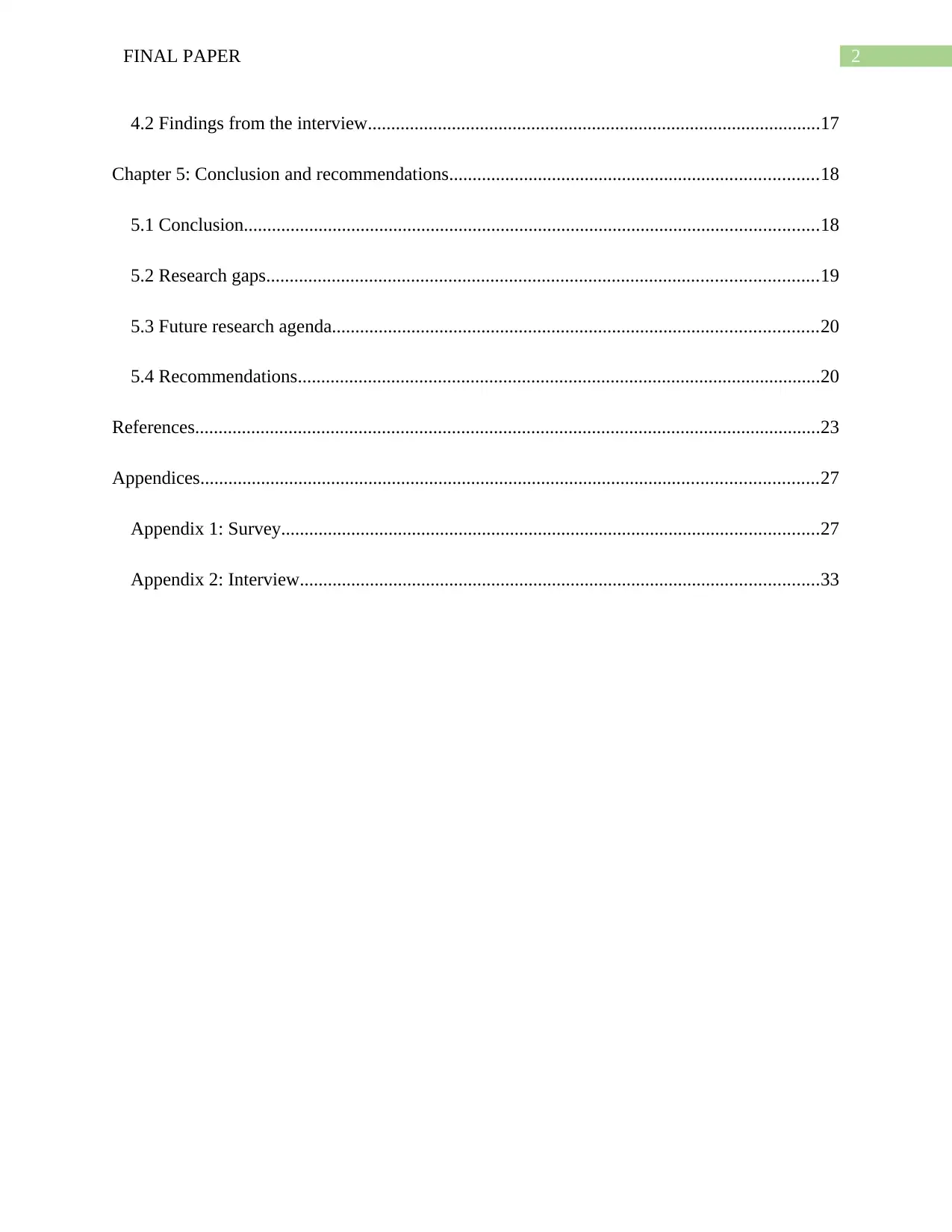
2FINAL PAPER
4.2 Findings from the interview.................................................................................................17
Chapter 5: Conclusion and recommendations...............................................................................18
5.1 Conclusion...........................................................................................................................18
5.2 Research gaps......................................................................................................................19
5.3 Future research agenda........................................................................................................20
5.4 Recommendations................................................................................................................20
References......................................................................................................................................23
Appendices....................................................................................................................................27
Appendix 1: Survey...................................................................................................................27
Appendix 2: Interview...............................................................................................................33
4.2 Findings from the interview.................................................................................................17
Chapter 5: Conclusion and recommendations...............................................................................18
5.1 Conclusion...........................................................................................................................18
5.2 Research gaps......................................................................................................................19
5.3 Future research agenda........................................................................................................20
5.4 Recommendations................................................................................................................20
References......................................................................................................................................23
Appendices....................................................................................................................................27
Appendix 1: Survey...................................................................................................................27
Appendix 2: Interview...............................................................................................................33
⊘ This is a preview!⊘
Do you want full access?
Subscribe today to unlock all pages.

Trusted by 1+ million students worldwide
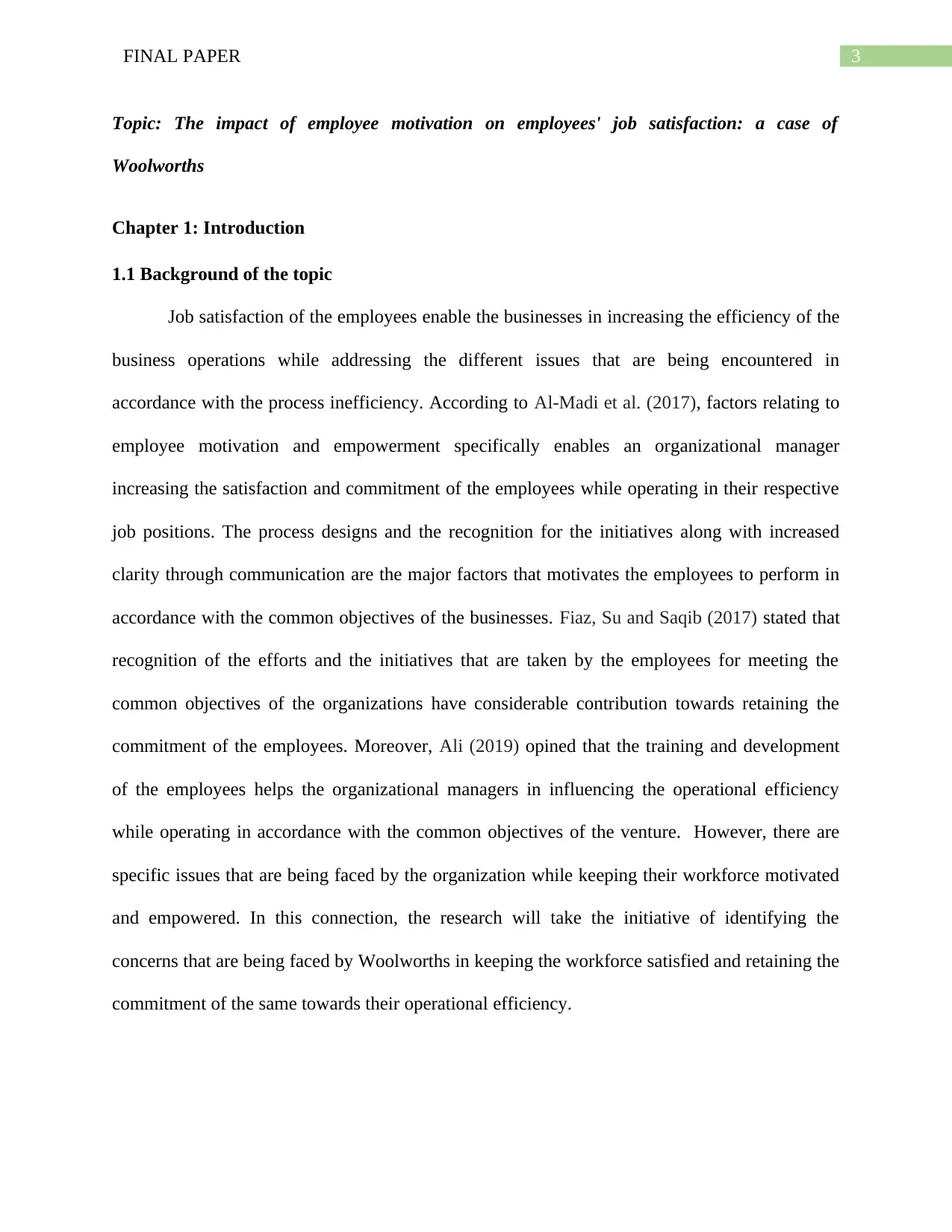
3FINAL PAPER
Topic: The impact of employee motivation on employees' job satisfaction: a case of
Woolworths
Chapter 1: Introduction
1.1 Background of the topic
Job satisfaction of the employees enable the businesses in increasing the efficiency of the
business operations while addressing the different issues that are being encountered in
accordance with the process inefficiency. According to Al-Madi et al. (2017), factors relating to
employee motivation and empowerment specifically enables an organizational manager
increasing the satisfaction and commitment of the employees while operating in their respective
job positions. The process designs and the recognition for the initiatives along with increased
clarity through communication are the major factors that motivates the employees to perform in
accordance with the common objectives of the businesses. Fiaz, Su and Saqib (2017) stated that
recognition of the efforts and the initiatives that are taken by the employees for meeting the
common objectives of the organizations have considerable contribution towards retaining the
commitment of the employees. Moreover, Ali (2019) opined that the training and development
of the employees helps the organizational managers in influencing the operational efficiency
while operating in accordance with the common objectives of the venture. However, there are
specific issues that are being faced by the organization while keeping their workforce motivated
and empowered. In this connection, the research will take the initiative of identifying the
concerns that are being faced by Woolworths in keeping the workforce satisfied and retaining the
commitment of the same towards their operational efficiency.
Topic: The impact of employee motivation on employees' job satisfaction: a case of
Woolworths
Chapter 1: Introduction
1.1 Background of the topic
Job satisfaction of the employees enable the businesses in increasing the efficiency of the
business operations while addressing the different issues that are being encountered in
accordance with the process inefficiency. According to Al-Madi et al. (2017), factors relating to
employee motivation and empowerment specifically enables an organizational manager
increasing the satisfaction and commitment of the employees while operating in their respective
job positions. The process designs and the recognition for the initiatives along with increased
clarity through communication are the major factors that motivates the employees to perform in
accordance with the common objectives of the businesses. Fiaz, Su and Saqib (2017) stated that
recognition of the efforts and the initiatives that are taken by the employees for meeting the
common objectives of the organizations have considerable contribution towards retaining the
commitment of the employees. Moreover, Ali (2019) opined that the training and development
of the employees helps the organizational managers in influencing the operational efficiency
while operating in accordance with the common objectives of the venture. However, there are
specific issues that are being faced by the organization while keeping their workforce motivated
and empowered. In this connection, the research will take the initiative of identifying the
concerns that are being faced by Woolworths in keeping the workforce satisfied and retaining the
commitment of the same towards their operational efficiency.
Paraphrase This Document
Need a fresh take? Get an instant paraphrase of this document with our AI Paraphraser
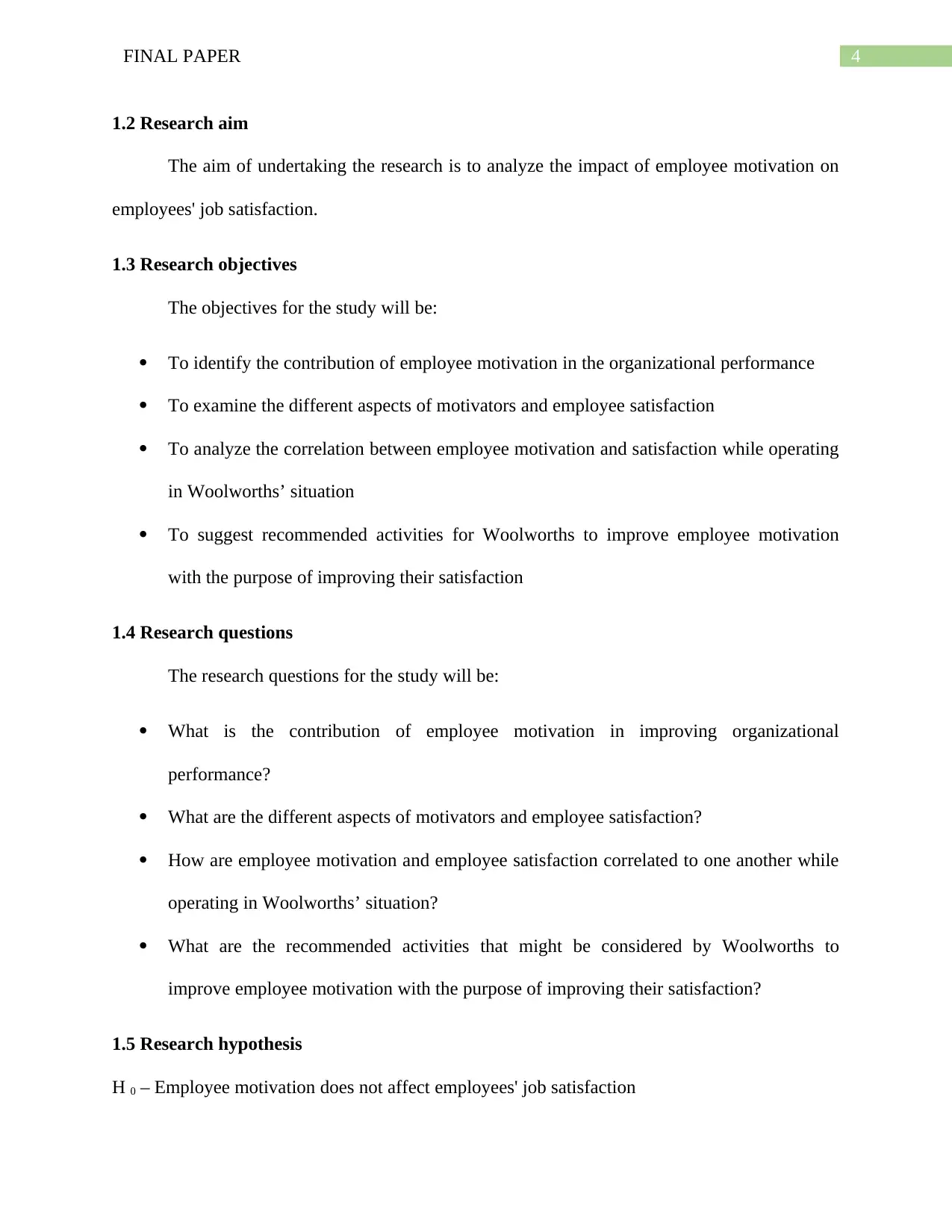
4FINAL PAPER
1.2 Research aim
The aim of undertaking the research is to analyze the impact of employee motivation on
employees' job satisfaction.
1.3 Research objectives
The objectives for the study will be:
To identify the contribution of employee motivation in the organizational performance
To examine the different aspects of motivators and employee satisfaction
To analyze the correlation between employee motivation and satisfaction while operating
in Woolworths’ situation
To suggest recommended activities for Woolworths to improve employee motivation
with the purpose of improving their satisfaction
1.4 Research questions
The research questions for the study will be:
What is the contribution of employee motivation in improving organizational
performance?
What are the different aspects of motivators and employee satisfaction?
How are employee motivation and employee satisfaction correlated to one another while
operating in Woolworths’ situation?
What are the recommended activities that might be considered by Woolworths to
improve employee motivation with the purpose of improving their satisfaction?
1.5 Research hypothesis
H 0 – Employee motivation does not affect employees' job satisfaction
1.2 Research aim
The aim of undertaking the research is to analyze the impact of employee motivation on
employees' job satisfaction.
1.3 Research objectives
The objectives for the study will be:
To identify the contribution of employee motivation in the organizational performance
To examine the different aspects of motivators and employee satisfaction
To analyze the correlation between employee motivation and satisfaction while operating
in Woolworths’ situation
To suggest recommended activities for Woolworths to improve employee motivation
with the purpose of improving their satisfaction
1.4 Research questions
The research questions for the study will be:
What is the contribution of employee motivation in improving organizational
performance?
What are the different aspects of motivators and employee satisfaction?
How are employee motivation and employee satisfaction correlated to one another while
operating in Woolworths’ situation?
What are the recommended activities that might be considered by Woolworths to
improve employee motivation with the purpose of improving their satisfaction?
1.5 Research hypothesis
H 0 – Employee motivation does not affect employees' job satisfaction
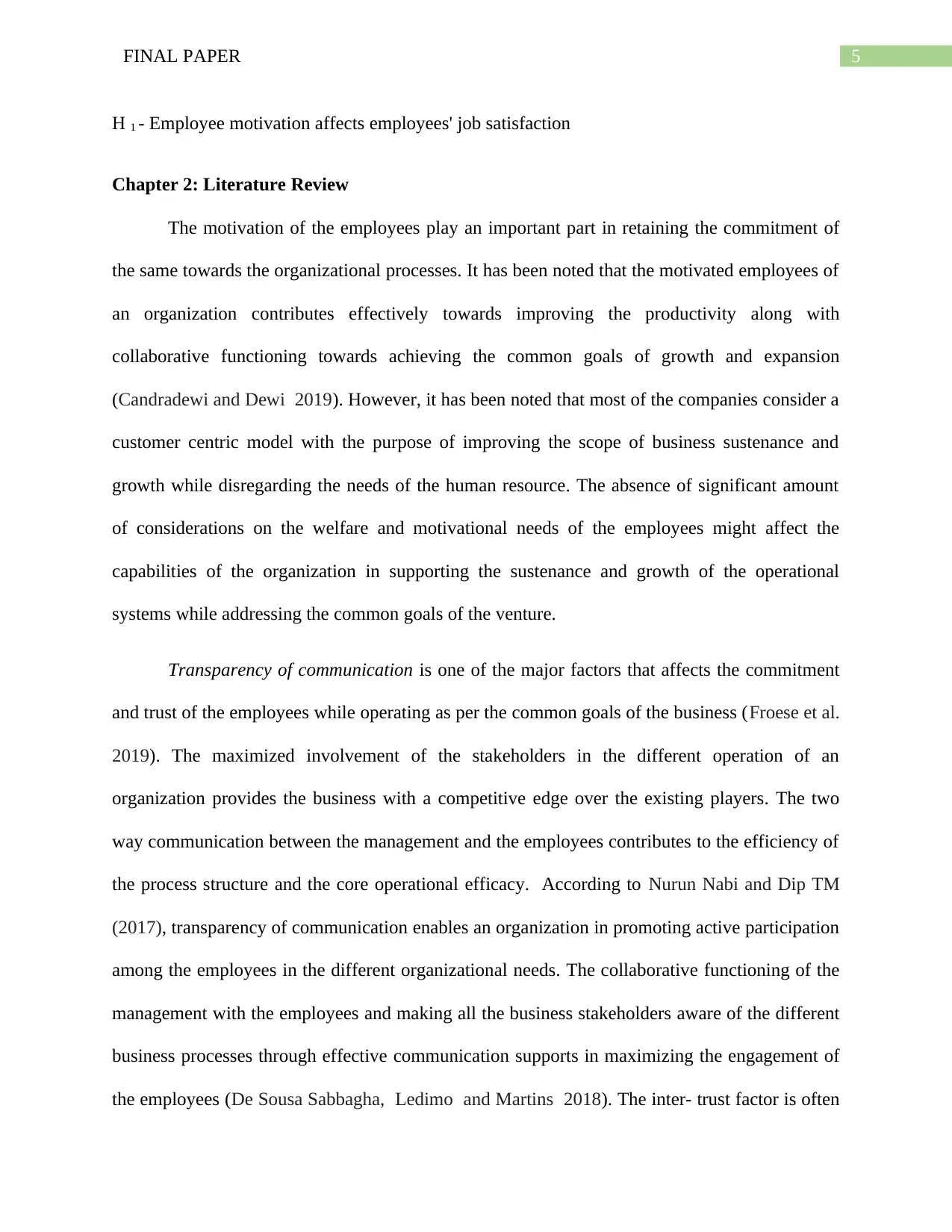
5FINAL PAPER
H 1 - Employee motivation affects employees' job satisfaction
Chapter 2: Literature Review
The motivation of the employees play an important part in retaining the commitment of
the same towards the organizational processes. It has been noted that the motivated employees of
an organization contributes effectively towards improving the productivity along with
collaborative functioning towards achieving the common goals of growth and expansion
(Candradewi and Dewi 2019). However, it has been noted that most of the companies consider a
customer centric model with the purpose of improving the scope of business sustenance and
growth while disregarding the needs of the human resource. The absence of significant amount
of considerations on the welfare and motivational needs of the employees might affect the
capabilities of the organization in supporting the sustenance and growth of the operational
systems while addressing the common goals of the venture.
Transparency of communication is one of the major factors that affects the commitment
and trust of the employees while operating as per the common goals of the business (Froese et al.
2019). The maximized involvement of the stakeholders in the different operation of an
organization provides the business with a competitive edge over the existing players. The two
way communication between the management and the employees contributes to the efficiency of
the process structure and the core operational efficacy. According to Nurun Nabi and Dip TM
(2017), transparency of communication enables an organization in promoting active participation
among the employees in the different organizational needs. The collaborative functioning of the
management with the employees and making all the business stakeholders aware of the different
business processes through effective communication supports in maximizing the engagement of
the employees (De Sousa Sabbagha, Ledimo and Martins 2018). The inter- trust factor is often
H 1 - Employee motivation affects employees' job satisfaction
Chapter 2: Literature Review
The motivation of the employees play an important part in retaining the commitment of
the same towards the organizational processes. It has been noted that the motivated employees of
an organization contributes effectively towards improving the productivity along with
collaborative functioning towards achieving the common goals of growth and expansion
(Candradewi and Dewi 2019). However, it has been noted that most of the companies consider a
customer centric model with the purpose of improving the scope of business sustenance and
growth while disregarding the needs of the human resource. The absence of significant amount
of considerations on the welfare and motivational needs of the employees might affect the
capabilities of the organization in supporting the sustenance and growth of the operational
systems while addressing the common goals of the venture.
Transparency of communication is one of the major factors that affects the commitment
and trust of the employees while operating as per the common goals of the business (Froese et al.
2019). The maximized involvement of the stakeholders in the different operation of an
organization provides the business with a competitive edge over the existing players. The two
way communication between the management and the employees contributes to the efficiency of
the process structure and the core operational efficacy. According to Nurun Nabi and Dip TM
(2017), transparency of communication enables an organization in promoting active participation
among the employees in the different organizational needs. The collaborative functioning of the
management with the employees and making all the business stakeholders aware of the different
business processes through effective communication supports in maximizing the engagement of
the employees (De Sousa Sabbagha, Ledimo and Martins 2018). The inter- trust factor is often
⊘ This is a preview!⊘
Do you want full access?
Subscribe today to unlock all pages.

Trusted by 1+ million students worldwide
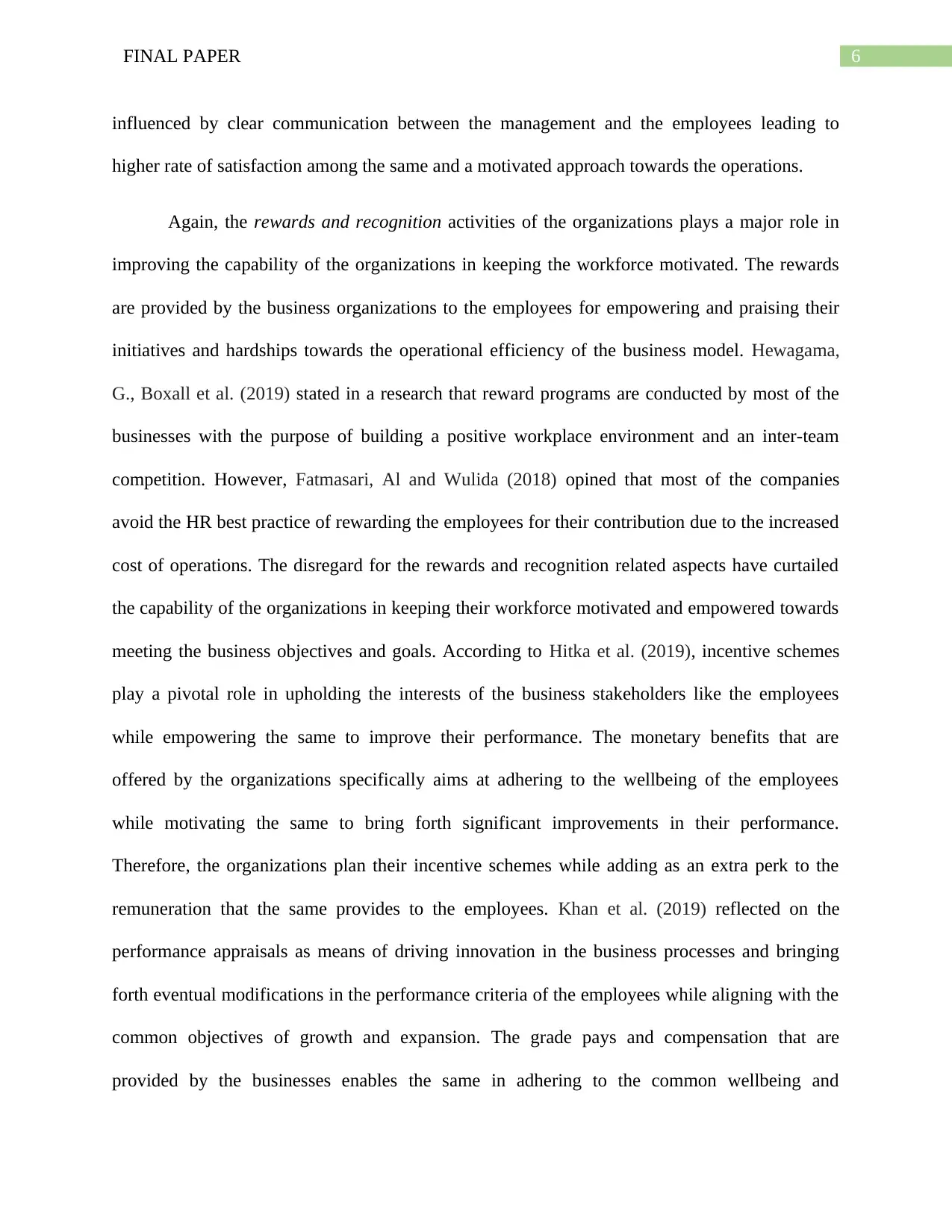
6FINAL PAPER
influenced by clear communication between the management and the employees leading to
higher rate of satisfaction among the same and a motivated approach towards the operations.
Again, the rewards and recognition activities of the organizations plays a major role in
improving the capability of the organizations in keeping the workforce motivated. The rewards
are provided by the business organizations to the employees for empowering and praising their
initiatives and hardships towards the operational efficiency of the business model. Hewagama,
G., Boxall et al. (2019) stated in a research that reward programs are conducted by most of the
businesses with the purpose of building a positive workplace environment and an inter-team
competition. However, Fatmasari, Al and Wulida (2018) opined that most of the companies
avoid the HR best practice of rewarding the employees for their contribution due to the increased
cost of operations. The disregard for the rewards and recognition related aspects have curtailed
the capability of the organizations in keeping their workforce motivated and empowered towards
meeting the business objectives and goals. According to Hitka et al. (2019), incentive schemes
play a pivotal role in upholding the interests of the business stakeholders like the employees
while empowering the same to improve their performance. The monetary benefits that are
offered by the organizations specifically aims at adhering to the wellbeing of the employees
while motivating the same to bring forth significant improvements in their performance.
Therefore, the organizations plan their incentive schemes while adding as an extra perk to the
remuneration that the same provides to the employees. Khan et al. (2019) reflected on the
performance appraisals as means of driving innovation in the business processes and bringing
forth eventual modifications in the performance criteria of the employees while aligning with the
common objectives of growth and expansion. The grade pays and compensation that are
provided by the businesses enables the same in adhering to the common wellbeing and
influenced by clear communication between the management and the employees leading to
higher rate of satisfaction among the same and a motivated approach towards the operations.
Again, the rewards and recognition activities of the organizations plays a major role in
improving the capability of the organizations in keeping the workforce motivated. The rewards
are provided by the business organizations to the employees for empowering and praising their
initiatives and hardships towards the operational efficiency of the business model. Hewagama,
G., Boxall et al. (2019) stated in a research that reward programs are conducted by most of the
businesses with the purpose of building a positive workplace environment and an inter-team
competition. However, Fatmasari, Al and Wulida (2018) opined that most of the companies
avoid the HR best practice of rewarding the employees for their contribution due to the increased
cost of operations. The disregard for the rewards and recognition related aspects have curtailed
the capability of the organizations in keeping their workforce motivated and empowered towards
meeting the business objectives and goals. According to Hitka et al. (2019), incentive schemes
play a pivotal role in upholding the interests of the business stakeholders like the employees
while empowering the same to improve their performance. The monetary benefits that are
offered by the organizations specifically aims at adhering to the wellbeing of the employees
while motivating the same to bring forth significant improvements in their performance.
Therefore, the organizations plan their incentive schemes while adding as an extra perk to the
remuneration that the same provides to the employees. Khan et al. (2019) reflected on the
performance appraisals as means of driving innovation in the business processes and bringing
forth eventual modifications in the performance criteria of the employees while aligning with the
common objectives of growth and expansion. The grade pays and compensation that are
provided by the businesses enables the same in adhering to the common wellbeing and
Paraphrase This Document
Need a fresh take? Get an instant paraphrase of this document with our AI Paraphraser
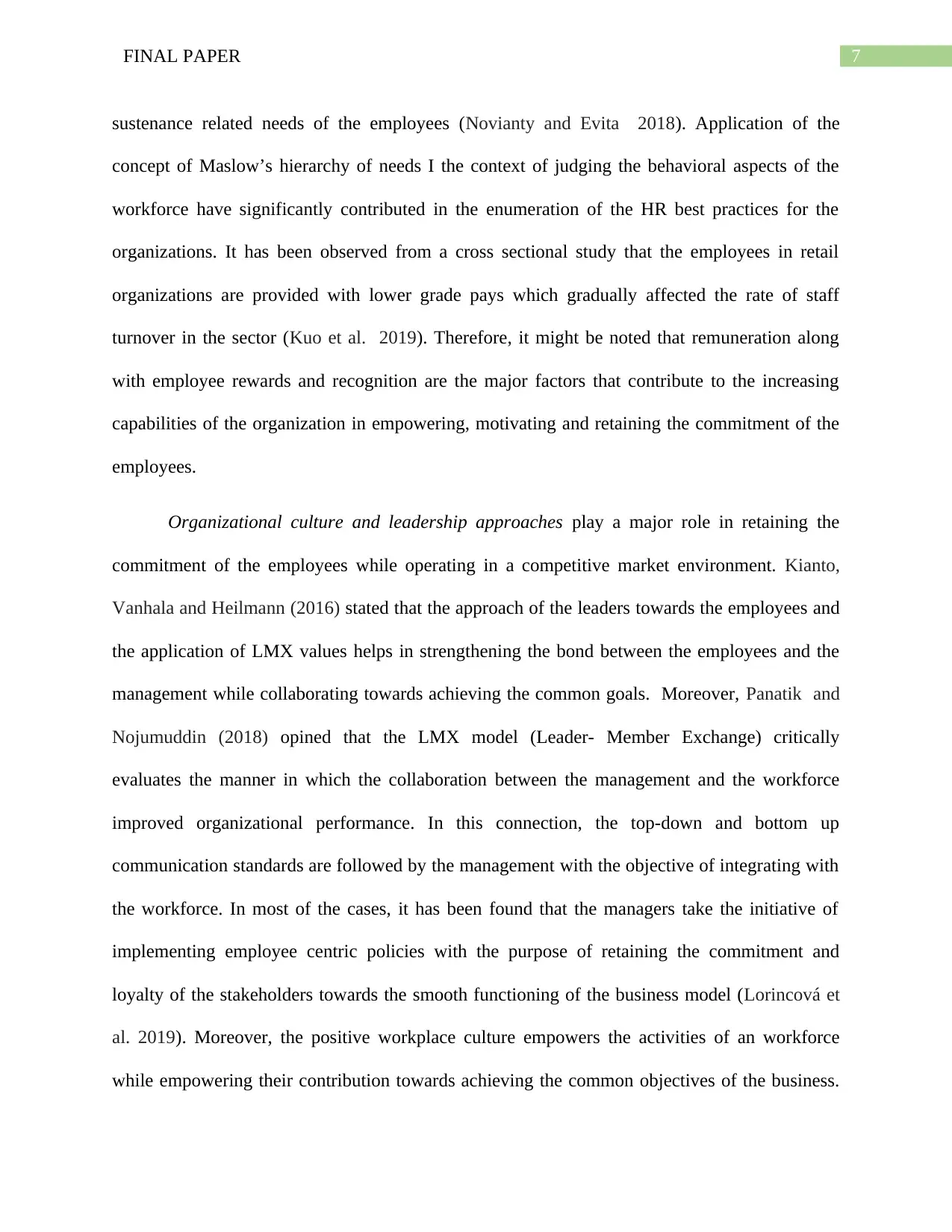
7FINAL PAPER
sustenance related needs of the employees (Novianty and Evita 2018). Application of the
concept of Maslow’s hierarchy of needs I the context of judging the behavioral aspects of the
workforce have significantly contributed in the enumeration of the HR best practices for the
organizations. It has been observed from a cross sectional study that the employees in retail
organizations are provided with lower grade pays which gradually affected the rate of staff
turnover in the sector (Kuo et al. 2019). Therefore, it might be noted that remuneration along
with employee rewards and recognition are the major factors that contribute to the increasing
capabilities of the organization in empowering, motivating and retaining the commitment of the
employees.
Organizational culture and leadership approaches play a major role in retaining the
commitment of the employees while operating in a competitive market environment. Kianto,
Vanhala and Heilmann (2016) stated that the approach of the leaders towards the employees and
the application of LMX values helps in strengthening the bond between the employees and the
management while collaborating towards achieving the common goals. Moreover, Panatik and
Nojumuddin (2018) opined that the LMX model (Leader- Member Exchange) critically
evaluates the manner in which the collaboration between the management and the workforce
improved organizational performance. In this connection, the top-down and bottom up
communication standards are followed by the management with the objective of integrating with
the workforce. In most of the cases, it has been found that the managers take the initiative of
implementing employee centric policies with the purpose of retaining the commitment and
loyalty of the stakeholders towards the smooth functioning of the business model (Lorincová et
al. 2019). Moreover, the positive workplace culture empowers the activities of an workforce
while empowering their contribution towards achieving the common objectives of the business.
sustenance related needs of the employees (Novianty and Evita 2018). Application of the
concept of Maslow’s hierarchy of needs I the context of judging the behavioral aspects of the
workforce have significantly contributed in the enumeration of the HR best practices for the
organizations. It has been observed from a cross sectional study that the employees in retail
organizations are provided with lower grade pays which gradually affected the rate of staff
turnover in the sector (Kuo et al. 2019). Therefore, it might be noted that remuneration along
with employee rewards and recognition are the major factors that contribute to the increasing
capabilities of the organization in empowering, motivating and retaining the commitment of the
employees.
Organizational culture and leadership approaches play a major role in retaining the
commitment of the employees while operating in a competitive market environment. Kianto,
Vanhala and Heilmann (2016) stated that the approach of the leaders towards the employees and
the application of LMX values helps in strengthening the bond between the employees and the
management while collaborating towards achieving the common goals. Moreover, Panatik and
Nojumuddin (2018) opined that the LMX model (Leader- Member Exchange) critically
evaluates the manner in which the collaboration between the management and the workforce
improved organizational performance. In this connection, the top-down and bottom up
communication standards are followed by the management with the objective of integrating with
the workforce. In most of the cases, it has been found that the managers take the initiative of
implementing employee centric policies with the purpose of retaining the commitment and
loyalty of the stakeholders towards the smooth functioning of the business model (Lorincová et
al. 2019). Moreover, the positive workplace culture empowers the activities of an workforce
while empowering their contribution towards achieving the common objectives of the business.
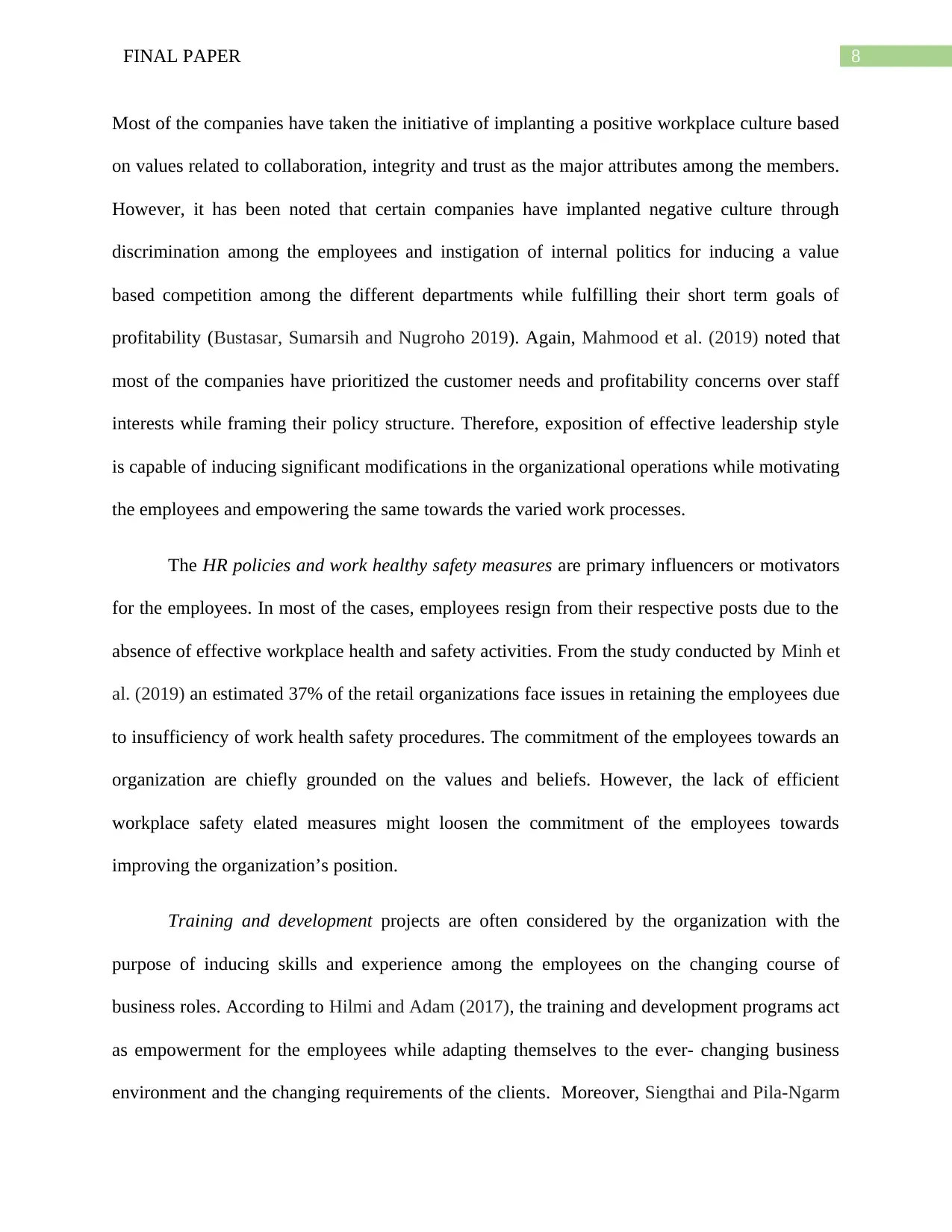
8FINAL PAPER
Most of the companies have taken the initiative of implanting a positive workplace culture based
on values related to collaboration, integrity and trust as the major attributes among the members.
However, it has been noted that certain companies have implanted negative culture through
discrimination among the employees and instigation of internal politics for inducing a value
based competition among the different departments while fulfilling their short term goals of
profitability (Bustasar, Sumarsih and Nugroho 2019). Again, Mahmood et al. (2019) noted that
most of the companies have prioritized the customer needs and profitability concerns over staff
interests while framing their policy structure. Therefore, exposition of effective leadership style
is capable of inducing significant modifications in the organizational operations while motivating
the employees and empowering the same towards the varied work processes.
The HR policies and work healthy safety measures are primary influencers or motivators
for the employees. In most of the cases, employees resign from their respective posts due to the
absence of effective workplace health and safety activities. From the study conducted by Minh et
al. (2019) an estimated 37% of the retail organizations face issues in retaining the employees due
to insufficiency of work health safety procedures. The commitment of the employees towards an
organization are chiefly grounded on the values and beliefs. However, the lack of efficient
workplace safety elated measures might loosen the commitment of the employees towards
improving the organization’s position.
Training and development projects are often considered by the organization with the
purpose of inducing skills and experience among the employees on the changing course of
business roles. According to Hilmi and Adam (2017), the training and development programs act
as empowerment for the employees while adapting themselves to the ever- changing business
environment and the changing requirements of the clients. Moreover, Siengthai and Pila-Ngarm
Most of the companies have taken the initiative of implanting a positive workplace culture based
on values related to collaboration, integrity and trust as the major attributes among the members.
However, it has been noted that certain companies have implanted negative culture through
discrimination among the employees and instigation of internal politics for inducing a value
based competition among the different departments while fulfilling their short term goals of
profitability (Bustasar, Sumarsih and Nugroho 2019). Again, Mahmood et al. (2019) noted that
most of the companies have prioritized the customer needs and profitability concerns over staff
interests while framing their policy structure. Therefore, exposition of effective leadership style
is capable of inducing significant modifications in the organizational operations while motivating
the employees and empowering the same towards the varied work processes.
The HR policies and work healthy safety measures are primary influencers or motivators
for the employees. In most of the cases, employees resign from their respective posts due to the
absence of effective workplace health and safety activities. From the study conducted by Minh et
al. (2019) an estimated 37% of the retail organizations face issues in retaining the employees due
to insufficiency of work health safety procedures. The commitment of the employees towards an
organization are chiefly grounded on the values and beliefs. However, the lack of efficient
workplace safety elated measures might loosen the commitment of the employees towards
improving the organization’s position.
Training and development projects are often considered by the organization with the
purpose of inducing skills and experience among the employees on the changing course of
business roles. According to Hilmi and Adam (2017), the training and development programs act
as empowerment for the employees while adapting themselves to the ever- changing business
environment and the changing requirements of the clients. Moreover, Siengthai and Pila-Ngarm
⊘ This is a preview!⊘
Do you want full access?
Subscribe today to unlock all pages.

Trusted by 1+ million students worldwide
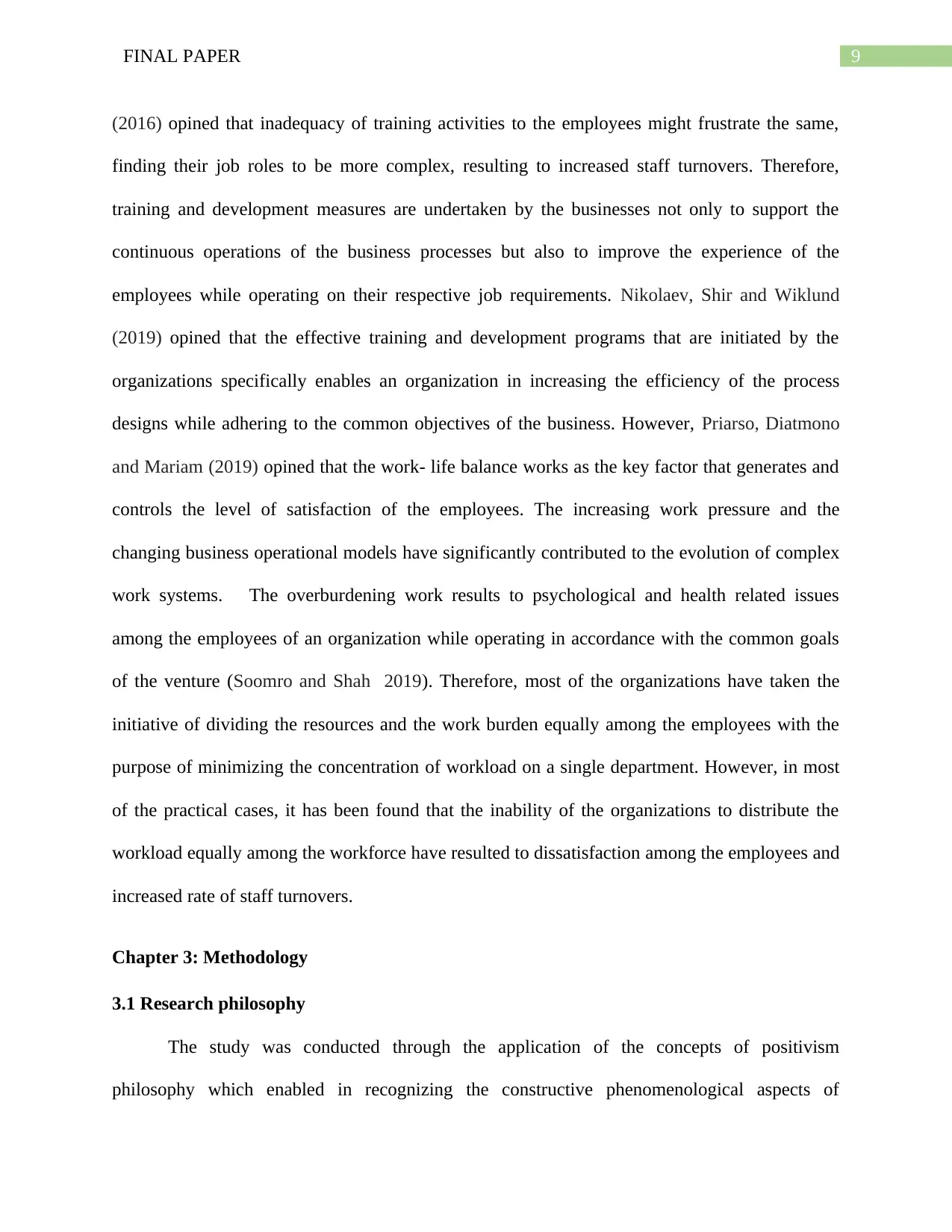
9FINAL PAPER
(2016) opined that inadequacy of training activities to the employees might frustrate the same,
finding their job roles to be more complex, resulting to increased staff turnovers. Therefore,
training and development measures are undertaken by the businesses not only to support the
continuous operations of the business processes but also to improve the experience of the
employees while operating on their respective job requirements. Nikolaev, Shir and Wiklund
(2019) opined that the effective training and development programs that are initiated by the
organizations specifically enables an organization in increasing the efficiency of the process
designs while adhering to the common objectives of the business. However, Priarso, Diatmono
and Mariam (2019) opined that the work- life balance works as the key factor that generates and
controls the level of satisfaction of the employees. The increasing work pressure and the
changing business operational models have significantly contributed to the evolution of complex
work systems. The overburdening work results to psychological and health related issues
among the employees of an organization while operating in accordance with the common goals
of the venture (Soomro and Shah 2019). Therefore, most of the organizations have taken the
initiative of dividing the resources and the work burden equally among the employees with the
purpose of minimizing the concentration of workload on a single department. However, in most
of the practical cases, it has been found that the inability of the organizations to distribute the
workload equally among the workforce have resulted to dissatisfaction among the employees and
increased rate of staff turnovers.
Chapter 3: Methodology
3.1 Research philosophy
The study was conducted through the application of the concepts of positivism
philosophy which enabled in recognizing the constructive phenomenological aspects of
(2016) opined that inadequacy of training activities to the employees might frustrate the same,
finding their job roles to be more complex, resulting to increased staff turnovers. Therefore,
training and development measures are undertaken by the businesses not only to support the
continuous operations of the business processes but also to improve the experience of the
employees while operating on their respective job requirements. Nikolaev, Shir and Wiklund
(2019) opined that the effective training and development programs that are initiated by the
organizations specifically enables an organization in increasing the efficiency of the process
designs while adhering to the common objectives of the business. However, Priarso, Diatmono
and Mariam (2019) opined that the work- life balance works as the key factor that generates and
controls the level of satisfaction of the employees. The increasing work pressure and the
changing business operational models have significantly contributed to the evolution of complex
work systems. The overburdening work results to psychological and health related issues
among the employees of an organization while operating in accordance with the common goals
of the venture (Soomro and Shah 2019). Therefore, most of the organizations have taken the
initiative of dividing the resources and the work burden equally among the employees with the
purpose of minimizing the concentration of workload on a single department. However, in most
of the practical cases, it has been found that the inability of the organizations to distribute the
workload equally among the workforce have resulted to dissatisfaction among the employees and
increased rate of staff turnovers.
Chapter 3: Methodology
3.1 Research philosophy
The study was conducted through the application of the concepts of positivism
philosophy which enabled in recognizing the constructive phenomenological aspects of
Paraphrase This Document
Need a fresh take? Get an instant paraphrase of this document with our AI Paraphraser
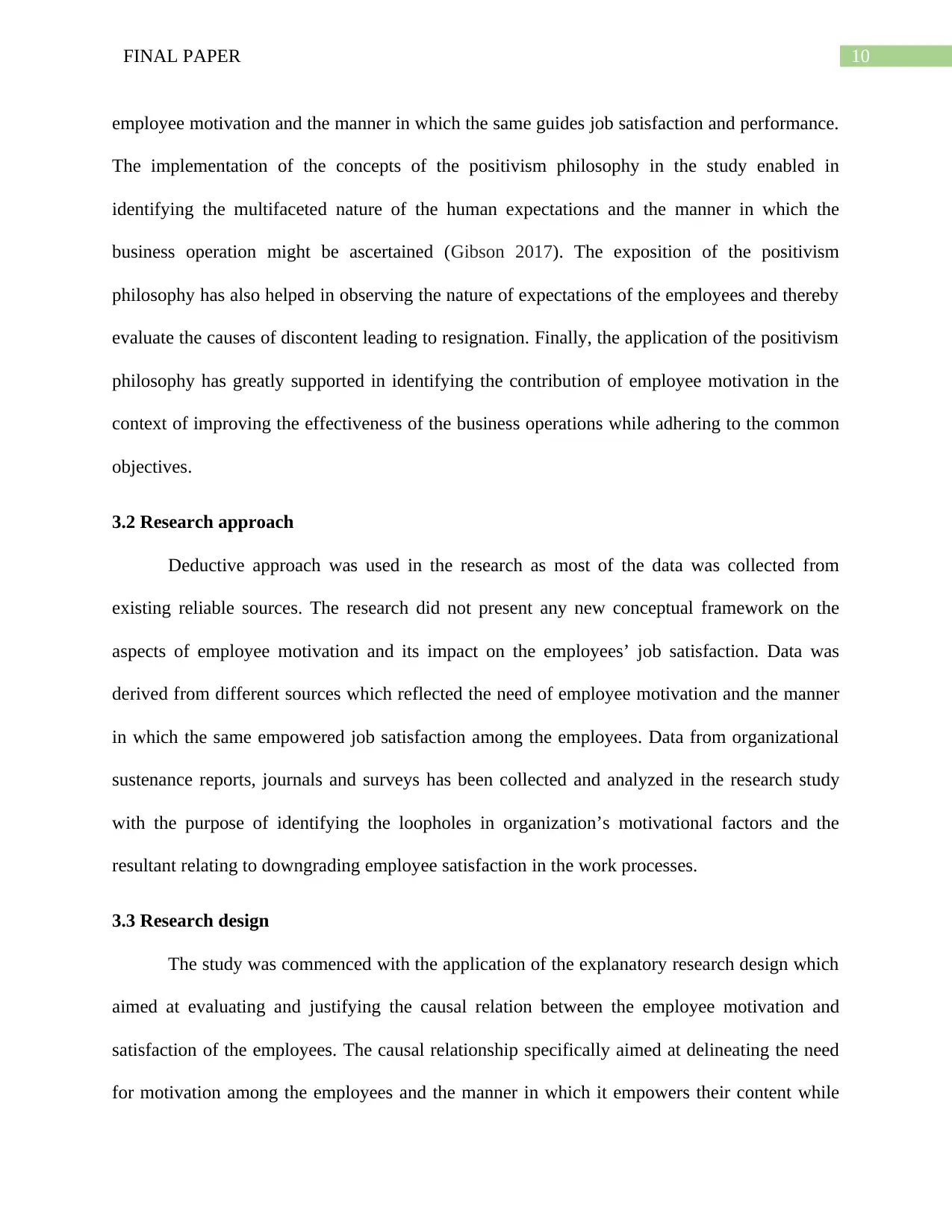
10FINAL PAPER
employee motivation and the manner in which the same guides job satisfaction and performance.
The implementation of the concepts of the positivism philosophy in the study enabled in
identifying the multifaceted nature of the human expectations and the manner in which the
business operation might be ascertained (Gibson 2017). The exposition of the positivism
philosophy has also helped in observing the nature of expectations of the employees and thereby
evaluate the causes of discontent leading to resignation. Finally, the application of the positivism
philosophy has greatly supported in identifying the contribution of employee motivation in the
context of improving the effectiveness of the business operations while adhering to the common
objectives.
3.2 Research approach
Deductive approach was used in the research as most of the data was collected from
existing reliable sources. The research did not present any new conceptual framework on the
aspects of employee motivation and its impact on the employees’ job satisfaction. Data was
derived from different sources which reflected the need of employee motivation and the manner
in which the same empowered job satisfaction among the employees. Data from organizational
sustenance reports, journals and surveys has been collected and analyzed in the research study
with the purpose of identifying the loopholes in organization’s motivational factors and the
resultant relating to downgrading employee satisfaction in the work processes.
3.3 Research design
The study was commenced with the application of the explanatory research design which
aimed at evaluating and justifying the causal relation between the employee motivation and
satisfaction of the employees. The causal relationship specifically aimed at delineating the need
for motivation among the employees and the manner in which it empowers their content while
employee motivation and the manner in which the same guides job satisfaction and performance.
The implementation of the concepts of the positivism philosophy in the study enabled in
identifying the multifaceted nature of the human expectations and the manner in which the
business operation might be ascertained (Gibson 2017). The exposition of the positivism
philosophy has also helped in observing the nature of expectations of the employees and thereby
evaluate the causes of discontent leading to resignation. Finally, the application of the positivism
philosophy has greatly supported in identifying the contribution of employee motivation in the
context of improving the effectiveness of the business operations while adhering to the common
objectives.
3.2 Research approach
Deductive approach was used in the research as most of the data was collected from
existing reliable sources. The research did not present any new conceptual framework on the
aspects of employee motivation and its impact on the employees’ job satisfaction. Data was
derived from different sources which reflected the need of employee motivation and the manner
in which the same empowered job satisfaction among the employees. Data from organizational
sustenance reports, journals and surveys has been collected and analyzed in the research study
with the purpose of identifying the loopholes in organization’s motivational factors and the
resultant relating to downgrading employee satisfaction in the work processes.
3.3 Research design
The study was commenced with the application of the explanatory research design which
aimed at evaluating and justifying the causal relation between the employee motivation and
satisfaction of the employees. The causal relationship specifically aimed at delineating the need
for motivation among the employees and the manner in which it empowers their content while
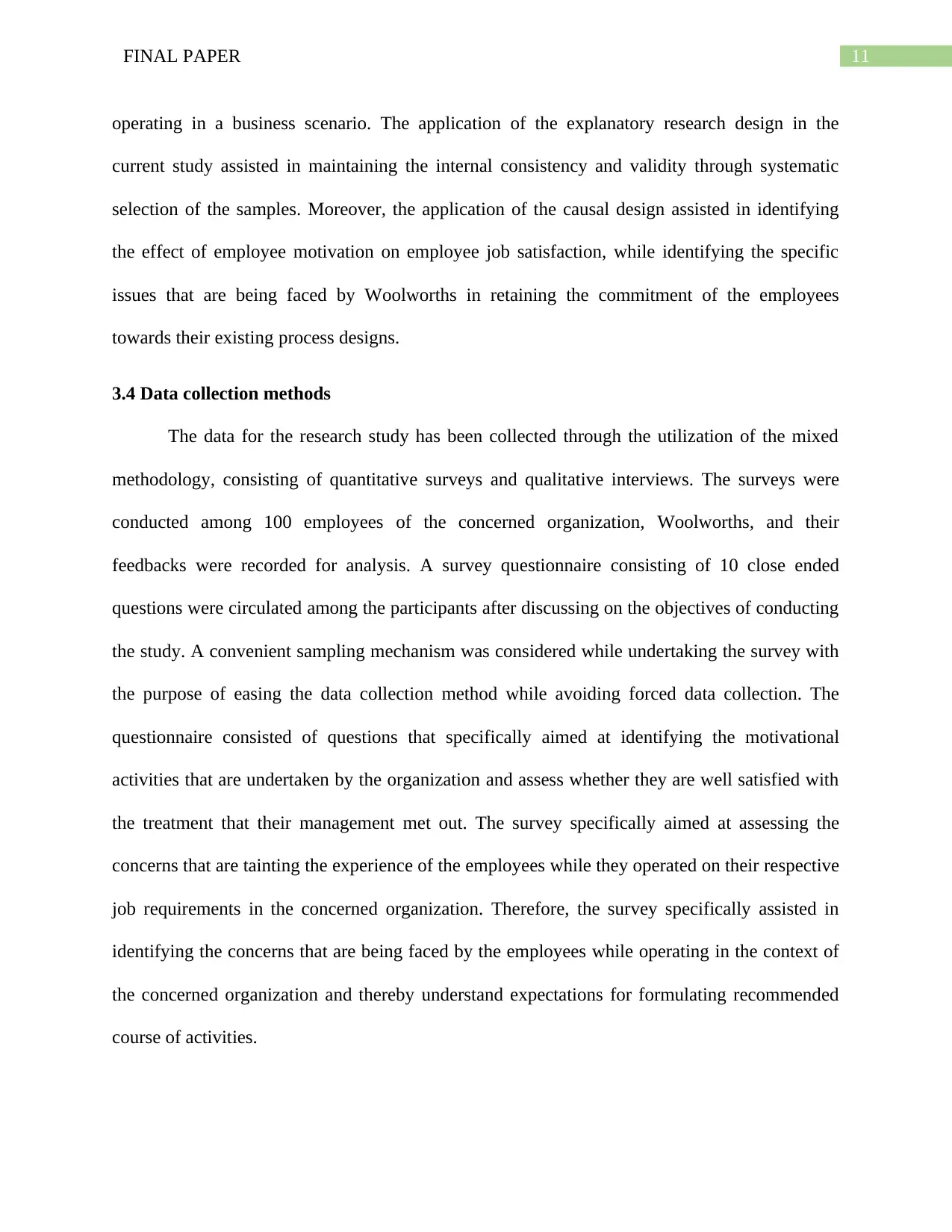
11FINAL PAPER
operating in a business scenario. The application of the explanatory research design in the
current study assisted in maintaining the internal consistency and validity through systematic
selection of the samples. Moreover, the application of the causal design assisted in identifying
the effect of employee motivation on employee job satisfaction, while identifying the specific
issues that are being faced by Woolworths in retaining the commitment of the employees
towards their existing process designs.
3.4 Data collection methods
The data for the research study has been collected through the utilization of the mixed
methodology, consisting of quantitative surveys and qualitative interviews. The surveys were
conducted among 100 employees of the concerned organization, Woolworths, and their
feedbacks were recorded for analysis. A survey questionnaire consisting of 10 close ended
questions were circulated among the participants after discussing on the objectives of conducting
the study. A convenient sampling mechanism was considered while undertaking the survey with
the purpose of easing the data collection method while avoiding forced data collection. The
questionnaire consisted of questions that specifically aimed at identifying the motivational
activities that are undertaken by the organization and assess whether they are well satisfied with
the treatment that their management met out. The survey specifically aimed at assessing the
concerns that are tainting the experience of the employees while they operated on their respective
job requirements in the concerned organization. Therefore, the survey specifically assisted in
identifying the concerns that are being faced by the employees while operating in the context of
the concerned organization and thereby understand expectations for formulating recommended
course of activities.
operating in a business scenario. The application of the explanatory research design in the
current study assisted in maintaining the internal consistency and validity through systematic
selection of the samples. Moreover, the application of the causal design assisted in identifying
the effect of employee motivation on employee job satisfaction, while identifying the specific
issues that are being faced by Woolworths in retaining the commitment of the employees
towards their existing process designs.
3.4 Data collection methods
The data for the research study has been collected through the utilization of the mixed
methodology, consisting of quantitative surveys and qualitative interviews. The surveys were
conducted among 100 employees of the concerned organization, Woolworths, and their
feedbacks were recorded for analysis. A survey questionnaire consisting of 10 close ended
questions were circulated among the participants after discussing on the objectives of conducting
the study. A convenient sampling mechanism was considered while undertaking the survey with
the purpose of easing the data collection method while avoiding forced data collection. The
questionnaire consisted of questions that specifically aimed at identifying the motivational
activities that are undertaken by the organization and assess whether they are well satisfied with
the treatment that their management met out. The survey specifically aimed at assessing the
concerns that are tainting the experience of the employees while they operated on their respective
job requirements in the concerned organization. Therefore, the survey specifically assisted in
identifying the concerns that are being faced by the employees while operating in the context of
the concerned organization and thereby understand expectations for formulating recommended
course of activities.
⊘ This is a preview!⊘
Do you want full access?
Subscribe today to unlock all pages.

Trusted by 1+ million students worldwide
1 out of 36
Related Documents
Your All-in-One AI-Powered Toolkit for Academic Success.
+13062052269
info@desklib.com
Available 24*7 on WhatsApp / Email
![[object Object]](/_next/static/media/star-bottom.7253800d.svg)
Unlock your academic potential
Copyright © 2020–2025 A2Z Services. All Rights Reserved. Developed and managed by ZUCOL.





